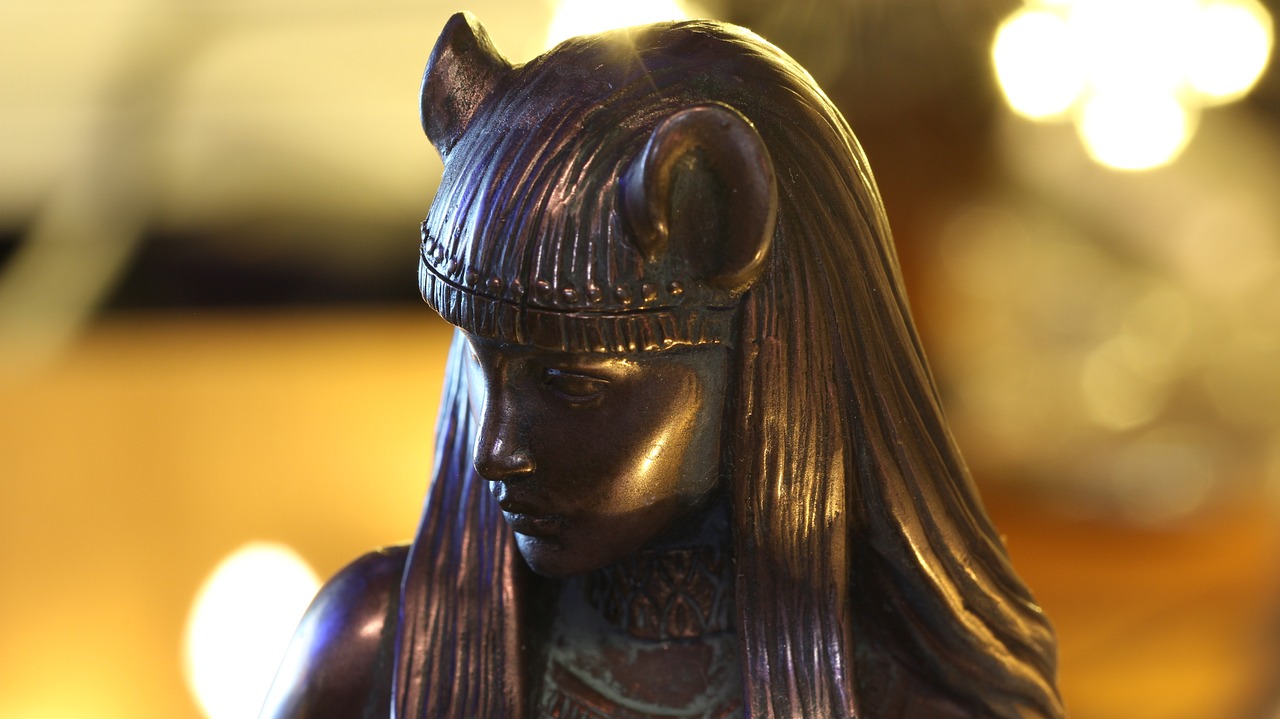Cats hold a prominent position in the art and culture of ancient Egypt, being repeatedly featured and symbolizing various attributes. The Egyptians had encounters with larger felines such as lions, panthers, and jungle cats in their environment, while smaller domestic cats cohabited with humans, adeptly managing pests around homes and granaries. This close interaction led the Egyptians to appreciate cats for their multifaceted nature, which merges elegance and nurturing tendencies with traits of aggression, quickness, and a hint of peril. The gods they worshipped were often depicted with feline features to represent these dual characteristics. However, it is critical to note that while cats were revered, they were not directly worshipped; instead, the gods sharing feline attributes were admired for qualities that were believed to resonate with these animals.
Bastet: The Feline Goddess
One of the most notable feline deities in Egyptian mythology is Bastet. Originally represented as a lioness, by the second millennium BCE, her form transitioned into that of a domestic cat or a woman with feline characteristics. Although Bastet embodied both protective and fierce traits, her nurturing qualities generally took precedence in her depictions. Numerous artifacts, such as statues of seated cats or cat-headed females often accompanied by kittens, bear inscriptions dedicated to Bastet. Such offerings were a means for worshippers to seek blessings of health, fertility, and overall protection.
In organizing the exhibition “Divine Felines: Cats of Ancient Egypt” at the Brooklyn Museum, I was inspired by a striking statuette of a goddess bearing a lion’s head and feminine form, which had been stored away since 1937 due to its damaged state. Intrigued by its aesthetic appeal and the fascinating melding of features, I set out to discover its origins.
This unique goddess is portrayed with a distinct tripartite wig and once wore a sun-disk ornament held in place by the bronze uraeus on her brow. She is sculpted in a pose where both her feet and rear rest on the ground, knees drawn in—a posture often representing gods in two-dimensional forms, specifically in temples or funerary art. Unlike typical three-dimensional depictions of lion-headed deities, which usually show them standing or seated on thrones, this statuette exemplifies a less common likeness. The base of this figure resembles the floral umbel of papyrus, often encountered with feline figures dedicated to Bastet, though it is atypical for a figure of this size. Additionally, embedded within its hollow form was a small cat mummy, raising questions about its purpose.
The Unusual Features of the Statuette
The distinctive elements of the Brooklyn statuette conjure a sense of intrigue and enigma. While some features resonate with widely recognized motifs in Egyptian art, the arrangement of these components is quite extraordinary. For instance, the crouching position is usually reserved for two-dimensional representations of deities found in tombs or temples, while three-dimensional representations tend to adopt more upright postures. The floral base, although commonly associated with smaller bronze artifacts, is rarely seen in large-scale wooden pieces or animal mummy containers.
Despite its unique representation, details within the statuette provide hints towards its identity. A range of significant goddesses were depicted with similar characteristics, including Bastet, Sekhmet, Mut, and Wadjet, among others. They were often connected to the Sun God and exhibited attributes reminiscent of felines. The connection between cats and the Sun in Egyptian thought was grounded in their coloration resembling the sun’s rays. Cats bask in sunlight, embodying warmth, which parallels the sun’s duality: both a life-giving force and a potential source of peril.
Feline Deities and their Symbolism
In the realm of Egyptian mythology, the nurturing and formidable nature of cat goddesses is famously represented by Bastet and Sekhmet, reflecting the complex duality of these divine figures. The mythological narrative encapsulates the idea that goddesses like Hathor-Tefnut can embody both gentle and fierce qualities. This multifaceted portrayal illustrates not just individual deities but a unified force of feline feminine power, capable of safeguarding and destroying in equal measure.
The cat mummy found within the Brooklyn statuette connects it to its function, as these animals were often mummified by the ancient Egyptians. Each mummified cat was associated with deities, serving as offerings to seek favor or express gratitude. Particularly in Bubastis, the heart of cat worship, thousands of cat mummies were interred in various forms, from intricately designed coffins to linen-wrapped creations.
To conclude, the Brooklyn Museum’s statuette likely served as an ornate container for a cat mummy, representing a physical manifestation of devotion to Bastet while also echoing ancient practices of honoring the complexities of feline nature.



